3-inch anti-aircraft gun M3
The 3-inch anti-aircraft gun M3 was an anti-aircraft gun developed from the earlier 3-inch M1917 and 3-inch M1918 guns which served throughout the 1930s, some into early World War II. By the time of the US entry into World War II, the 3-inch M3 was in the process of being replaced and may have seen action in the Pacific during World War II.[2]
| 3-inch anti-aircraft gun M3 | |
|---|---|
A 3-inch M3 anti-aircraft gun on a M2A2 carriage, preserved in Brazil | |
| Type | Anti-aircraft gun |
| Place of origin | USA |
| Service history | |
| In service | 1928–1945 |
| Used by | USA |
| Wars | World War II |
| Production history | |
| Designed | 1927 |
| Produced | 1928 |
| Variants | Anti-tank |
| Specifications | |
| Mass | Complete: 16,800 lb (7,600 kg) Barrel: 2,302 lb (1,044 kg) |
| Length | 25 ft (7.6 m) |
| Barrel length | 12.6 ft (3.8 m) 50 caliber |
| Width | 7 ft (2.1 m) |
| Height | 9.4 ft (2.9 m)[1] |
| Shell | Fixed QF 76.2 x 585R |
| Shell weight | Complete: 24.6 lb (11.2 kg) Projectile: 12.8 lb (5.8 kg) |
| Caliber | 76.2 mm (3 in) |
| Action | Semi-automatic |
| Breech | Vertical sliding-wedge |
| Recoil | Hydro-pneumatic |
| Carriage | Four wheel with four collapsible outriggers |
| Elevation | −1° to +80°[1] |
| Traverse | 360° |
| Rate of fire | 25 rpm |
| Muzzle velocity | 854 m/s (2,800 ft/s) |
| Effective firing range | 21,000 ft (6,400 m) +85° |
| Maximum firing range | 8.3 mi (13.4 km) +45°[1] |
History
During the late 1920s, M1917 and M1918 guns were fitted with removable barrel liners and re-designated as 3-inch M1, M2, or M3 guns, depending on the variant they were upgraded from. The most numerous variant was the M3 which was introduced in 1928 and consisted of a new barrel with a removable autofretted liner. During the 1930s further upgrades were proposed but these were abandoned with the adoption of the 90 mm gun M1 in 1938.[2]
Design
The M3 consisted of a 76.2 mm (3 in) barrel 50 calibers in length, which had a removable liner and a semi-automatic vertical sliding-wedge breech. The barrel had a hydro-pneumatic recoil system and when fired the breech ejected the shell casing and remained open until a new round was loaded. The M2A2 cruciform carriage had a circular center section and four perforated steel outriggers for stability. For transport, the outriggers folded and a two-wheeled, single axle bogie could be screwed onto the outriggers at each end. The carriage had pneumatic tires, electric brakes and was capable of being towed at high speeds. The gun was provided with a set of equilibrators and was capable of both high angle fire +80° and 360° of traverse.[1]
Anti-tank gun
In September 1940 a project started to adapt the 3-inch gun to the anti-tank role, starting with the T9 experimental model but equipping it with the breech, recoil system and carriage borrowed from the 105mm M2 howitzer. The gun was accepted for service as the 3-inch M5.[3]
A similar derivative of the T9 – the 3-inch M6 – was intended to be mounted on the M5 self-propelled gun, which was eventually abandoned. A final adaptation was the 3-inch M7, which included minor modifications for mounting on the M6 heavy tank and M10 tank destroyer. The M7 saw wide use although it was supplanted to some extent by more powerful weapons such as the 90mm M3 and the British QF 17 pounder. A total of 6,824 M7 guns were manufactured.[3]
Ammunition
The M3 fired a Fixed QF 76.2 × 585R round and a number of different styles of ammunition were available:
Photo gallery
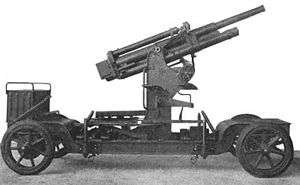 The predecessor of the M3; the M1918 in traveling position.
The predecessor of the M3; the M1918 in traveling position.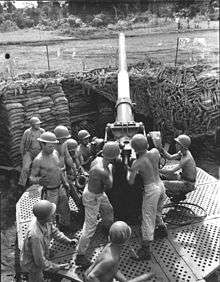 No. 2 Gun Crew, Btry D, 208th CA AA, man their 3-inch AA gun at New Fighter Strip, Dobodura, New Guinea (17 May 1943).
No. 2 Gun Crew, Btry D, 208th CA AA, man their 3-inch AA gun at New Fighter Strip, Dobodura, New Guinea (17 May 1943).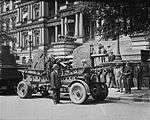 Secretary of War James W. Good inspects an M3 in traveling position near the White House in 1929.
Secretary of War James W. Good inspects an M3 in traveling position near the White House in 1929.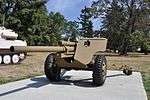 3-inch anti-tank gun M6 at Fort Lewis, Washington, USA.
3-inch anti-tank gun M6 at Fort Lewis, Washington, USA.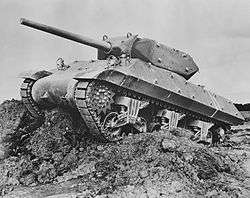 M10 tank destroyer with the 3-inch gun M7.
M10 tank destroyer with the 3-inch gun M7.
See also
Weapons of comparable role, performance and era
- British Vickers Model 1931
- Japanese Type 88 75 mm AA Gun
- Soviet 76 mm air defense gun M1931
References
- Hogg, Ian (2014-11-02). The American Arsenal: The World War II Official Standard Ordnance Catalogue. Barnsley, South Yorkshire. pp. 189–190. ISBN 9781473897021. OCLC 958355682.
- Chamberlain, Peter (1975). Anti-aircraft guns. Gander, Terry. New York: Arco Pub. Co. p. 56. ISBN 978-0668038188. OCLC 2000222.
- Chamberlain, Peter (1974). Anti-tank weapons. Gander, Terry. New York: Arco Pub. Co. p. 49. ISBN 978-0668036078. OCLC 1299755.
External links
